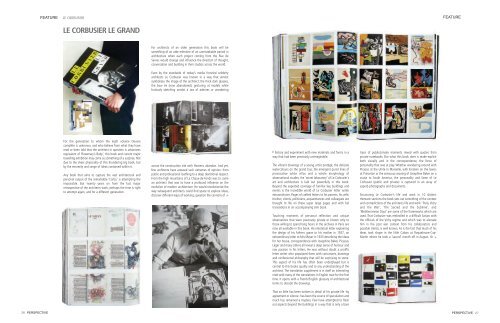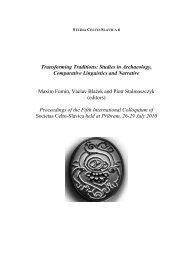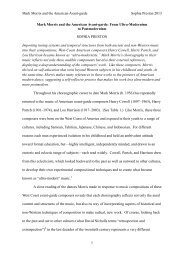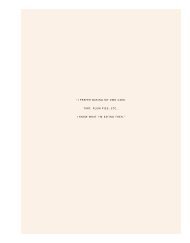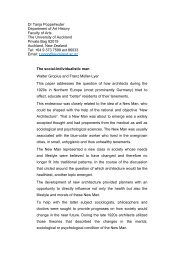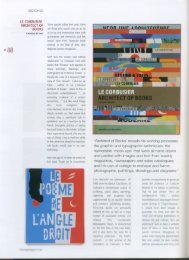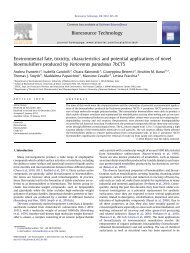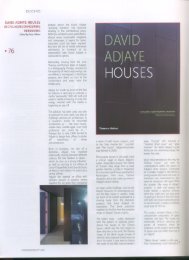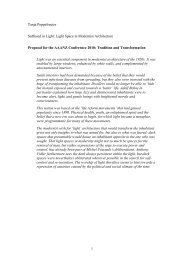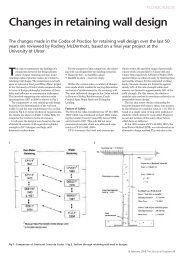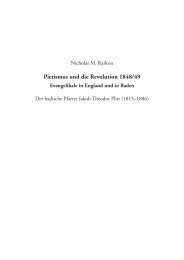PDF (Review of publication 'Le Corbusier Le Grand
PDF (Review of publication 'Le Corbusier Le Grand
PDF (Review of publication 'Le Corbusier Le Grand
You also want an ePaper? Increase the reach of your titles
YUMPU automatically turns print PDFs into web optimized ePapers that Google loves.
26<br />
PERSPECTIVE<br />
FEATURE LE CORBUSIER<br />
LE CORBUSIER LE GRAND<br />
For the generation to whom the eight volume Oeuvre<br />
complète is unknown, and who believe from what they have<br />
read or been told that the architect in question is urbanisms<br />
equivalent <strong>of</strong> ‘Rosemary’s Baby’, this book and current major<br />
travelling exhibition may come as something <strong>of</strong> a surprise. Not<br />
due to the sheer physicality <strong>of</strong> this thundering big book, but<br />
by the enormity and range <strong>of</strong> ideas contained within it.<br />
Any book that aims to capture the vast architectural and<br />
personal output <strong>of</strong> the remarkable ‘Corbu’ is attempting the<br />
impossible. But twenty years on from the last major<br />
retrospective <strong>of</strong> the architects work, perhaps the time is right<br />
to attempt again, and for a different generation.<br />
For architects <strong>of</strong> an older generation this book will be<br />
something <strong>of</strong> an aide mémoire <strong>of</strong> an unmistakable period in<br />
architecture when each project coming from the Rue de<br />
Sevres would change and influence the direction <strong>of</strong> thought,<br />
conversation and building in their studios across the world.<br />
Even by the standards <strong>of</strong> today’s media frenzied celebrity<br />
architects <strong>Le</strong> <strong>Corbusier</strong> was known in a way that almost<br />
symbolizes the image <strong>of</strong> the architect: the thick dark glasses,<br />
the bow tie (now abandoned), gesturing at models while<br />
furiously sketching amidst a sea <strong>of</strong> admires or wondering<br />
across the construction site with Homeric abandon. And yet,<br />
few architects have aroused such extremes <strong>of</strong> opinion: from<br />
public and pr<strong>of</strong>essional loathing to a deep devotional respect.<br />
From the high mountains <strong>of</strong> La Chaux-de-Fonds was to come<br />
an architect that was to have a pr<strong>of</strong>ound influence on the<br />
evolution <strong>of</strong> modern architecture. He would revolutionize the<br />
way subsequent architects could find space to explore ideas,<br />
discover different ways <strong>of</strong> working, question the cannons <strong>of</strong><br />
▲<br />
history and experiment with new materials and forms in a<br />
way that had been previously unimaginable.<br />
▲<br />
The vibrant drawings <strong>of</strong> a young artist protégé, the delicate<br />
watercolours on the grand tour, the emergent purist lines <strong>of</strong><br />
provocative white villas and a whole morphology <strong>of</strong><br />
observational studies, the ‘secret laboratory’ <strong>of</strong> <strong>Le</strong> <strong>Corbusier</strong>’s<br />
art and architecture is laid out powerfully in this book.<br />
Beyond the expected coverage <strong>of</strong> familiar key buildings and<br />
events is the incredible world <strong>of</strong> <strong>Le</strong> <strong>Corbusier</strong> letter writer<br />
extraordinaire. Pages <strong>of</strong> crafted letters to his parents, his wife,<br />
brother, clients, politicians, acquaintances and colleagues are<br />
brought to life on these super large pages and with full<br />
translations in an accompanying slim book.<br />
Touching moments <strong>of</strong> personal reflection and unique<br />
observations that were previously private or known only to<br />
those willing to spend long hours in the archives in Paris are<br />
now all available in this book. His emotional letter explaining<br />
the design <strong>of</strong> his fathers grave to his mother in 1927, an<br />
extraordinary letter to Mrs Meyer in 1925 describing the ideas<br />
for her house, correspondence with Josephine Baker, Picasso,<br />
Léger and many others all reveal a deep sense <strong>of</strong> humour and<br />
raw passion in his letters. He was without doubt a prolific<br />
letter writer who populated them with caricatures, drawings<br />
and confessional philosophy that will be surprising to some.<br />
This aspect <strong>of</strong> his life has <strong>of</strong>ten been underplayed but is<br />
central to this books quality and to any understanding <strong>of</strong> the<br />
architect. The translation supplement is in itself an interesting<br />
read with many <strong>of</strong> the translations in English now for the first<br />
time. It opens with a French/English glossary <strong>of</strong> architectural<br />
terms to decode the drawings.<br />
That so little has been written in detail <strong>of</strong> his private life -by<br />
agreement or silence- has been the source <strong>of</strong> speculation and<br />
much has remained a mystery. Few have attempted to flesh<br />
out aspects beyond the buildings in a way that is only a bare<br />
trace <strong>of</strong> public/private moments mixed with quotes from<br />
private notebooks. But what this book does is make explicit<br />
both visually and in the correspondence, the force <strong>of</strong><br />
personality that was at play. Whether wandering around with<br />
Picasso at the Unite in Marseille, with Einstein on the lawns<br />
at Princeton or the sensuous wooing <strong>of</strong> Josephine Baker on a<br />
cruise to South America, the personality and fame <strong>of</strong> <strong>Le</strong><br />
<strong>Corbusier</strong> (public and private) is captured in an array <strong>of</strong><br />
superb photographs and documents.<br />
Structuring <strong>Le</strong> <strong>Corbusier</strong>’s life and work in 10 distinct<br />
thematic sections the book sets out something <strong>of</strong> the context<br />
and contradictions <strong>of</strong> the architects life and work: ‘Paris, Vichy<br />
and the War’, ‘The Sacred and the Sublime’, and<br />
‘Mediterranean Days’ are some <strong>of</strong> the frameworks which are<br />
used. That <strong>Corbusier</strong> was embroiled in a difficult liaison with<br />
the <strong>of</strong>ficials <strong>of</strong> the Vichy regime and which was to alienate<br />
him in the post war context from his collaborators and<br />
possible clients, is well known. As is the fact that much <strong>of</strong> his<br />
ideas took shape in the little Caban at Roquebrune-Cap-<br />
Martin where he took a ‘sacred’ month <strong>of</strong>f in August. Or<br />
▲<br />
FEATURE<br />
PERSPECTIVE 27
26<br />
PERSPECTIVE<br />
FEATURE LE CORBUSIER<br />
that he painted every morning before travelling to the <strong>of</strong>fice,<br />
was all central to understanding his unique character.<br />
▲<br />
The spontaneity and power <strong>of</strong> the drawings and observations<br />
in <strong>Le</strong> <strong>Corbusier</strong> sketchbooks and journals are extraordinary.<br />
From the careful studies <strong>of</strong> churches in Florence, Greek<br />
sculpture, pottery, the ruins in Pompeii, the wing <strong>of</strong> an<br />
aeroplane, through to the contortionist gymnastics in Parisian<br />
Brothels, the architect’s eye took in everything, and recorded<br />
it for future use. Nothing was ignored or overlooked. The skill<br />
<strong>of</strong> the drawings brilliant and economic with line and tone are<br />
clear to see. The painful pencil drawing <strong>of</strong> the reclining head<br />
<strong>of</strong> his dying father, the debris <strong>of</strong> fishing boats at the edge <strong>of</strong><br />
the shoreline, female figures intertwined and dancing to<br />
music, the hills <strong>of</strong> Rio de Janeiro and the studies <strong>of</strong> the simple<br />
objects on the table around him are celebrated by the<br />
directness <strong>of</strong> the sketch and drawing, and are brought to life<br />
by the quality <strong>of</strong> reproduction in this book.<br />
Much has been made about the paintings that to some are<br />
only pseudo Picasso. But research has revealed the<br />
importance <strong>of</strong> a rich symbolic, mythic and iconographic<br />
reading <strong>of</strong> them. <strong>Le</strong> Poeme de l’Angle Droit, a testament and<br />
summation to his own personal philosophy extricate him from<br />
any narrow view <strong>of</strong> him as the dry, functional, machine<br />
aesthetician. The pebbles, shells and figure drawings reformed<br />
into symbolic animals and geometries are the key to<br />
such late works as Ronchamp or Chandigarh and can all be<br />
traced in the paintings. <strong>Le</strong> <strong>Corbusier</strong> refused to discuss his<br />
paintings and preferred that they speak for themselves. In a<br />
sense this is the approach <strong>of</strong> the book, not labouring any<br />
academic interpretation but providing a massive body <strong>of</strong> work<br />
for you to judge. Equally the introductory essay and short<br />
chapter introductions are concise and set the themes clearly,<br />
succinctly and usefully and are by two key <strong>Corbusier</strong><br />
historians: Tim Benton and Jean-Louis-Cohen, and these<br />
ensure its authority.<br />
While holding this book on your knees and as they begin to<br />
sag, the memory <strong>of</strong> Salvador Dali’s comment that <strong>Le</strong> <strong>Corbusier</strong><br />
turned into concrete and sank comes to mind. At almost 10kg<br />
the weight <strong>of</strong> modernism is hard to bare. In bookshops it has<br />
its own stand- a lectern for the faithful to pay homage. And so<br />
while Taschen and Phaidion play out a sumo contest <strong>of</strong> huge<br />
and lavish books and the number <strong>of</strong> <strong>publication</strong>s on <strong>Le</strong><br />
<strong>Corbusier</strong> reaches epic proportions this book will take its<br />
place in a series <strong>of</strong> memorable and collectible editions on <strong>Le</strong><br />
<strong>Corbusier</strong>. A big book suitable for the godfather <strong>of</strong> modern<br />
architecture it is an evocative and plentiful reference<br />
storehouse <strong>of</strong> well printed and considered material for both <strong>Le</strong><br />
<strong>Corbusier</strong> scholars and newcomers alike. At times a personal,<br />
almost private album made public, the collage <strong>of</strong> papers,<br />
sketches, photographs, letters, certificates, newspaper cuttings<br />
and passports makes revealing reading and study tracing the<br />
creative genealogy <strong>of</strong> the Swiss master. It has a big ambition<br />
that goes beyond the gimmick <strong>of</strong> its super large status. Maybe<br />
it will awaken a different reading or a new interest for some?<br />
Once on meeting Jane Drew -one <strong>of</strong> <strong>Le</strong> <strong>Corbusier</strong>’s key<br />
collaborators in India- and as we started talk, she told me<br />
outright to get the “<strong>Le</strong> <strong>Corbusier</strong> question over with”. It<br />
seemed that everyone always asked her the same question:<br />
”so what was he really like?” Maybe this book is another<br />
attempt to try to answer this.<br />
Paul Clarke<br />
LE CORBUSIER LE GRAND<br />
Phaidon pp 624 pages Hb<br />
2,000 illustrations – 1000 Colour £100<br />
www.phaidon.com


